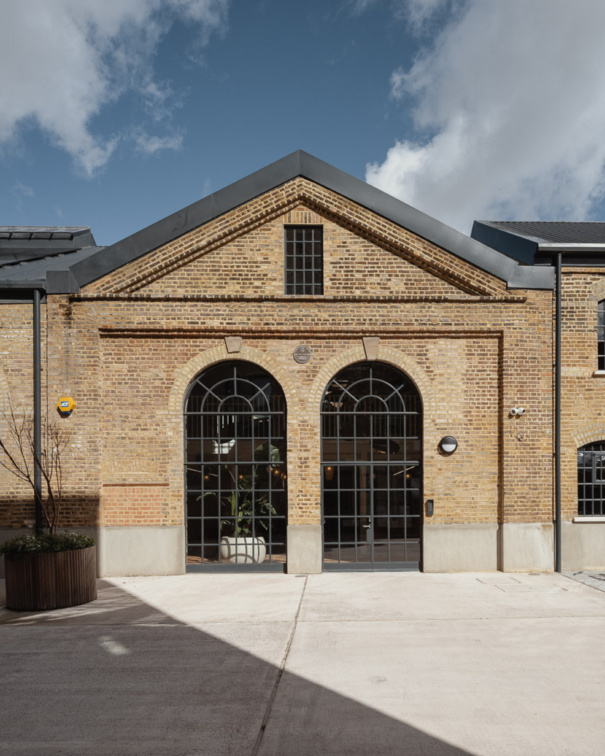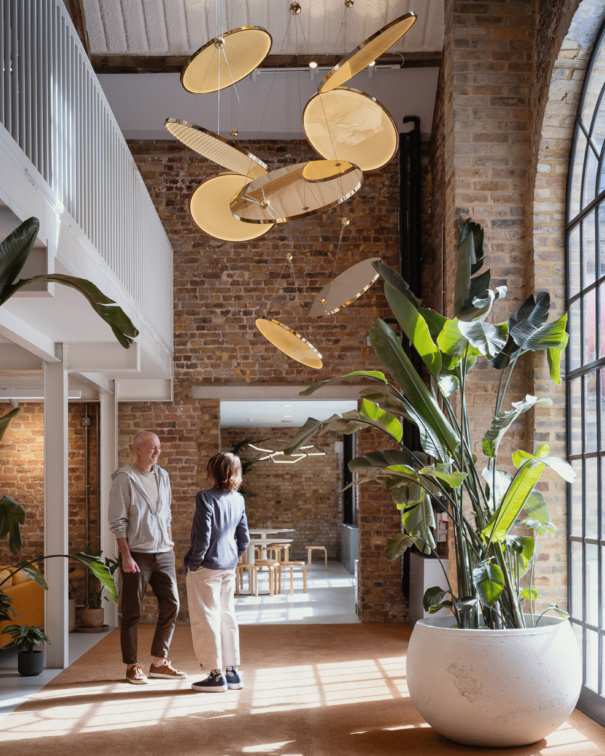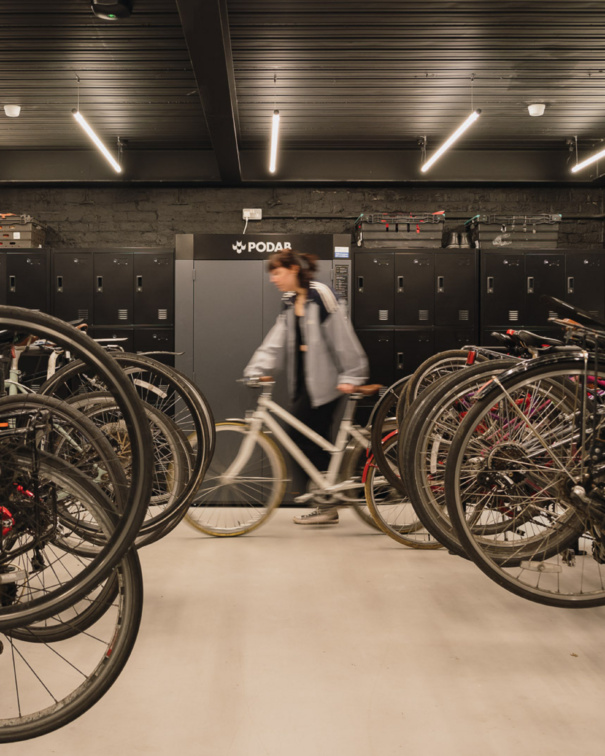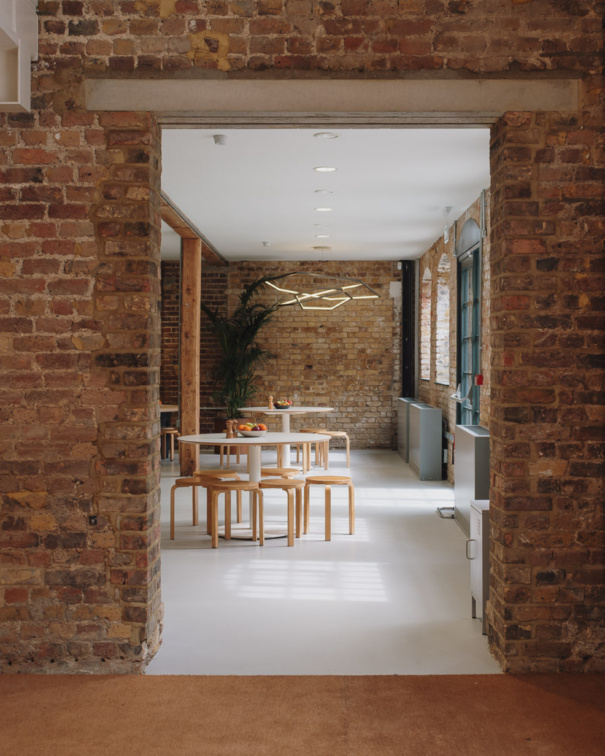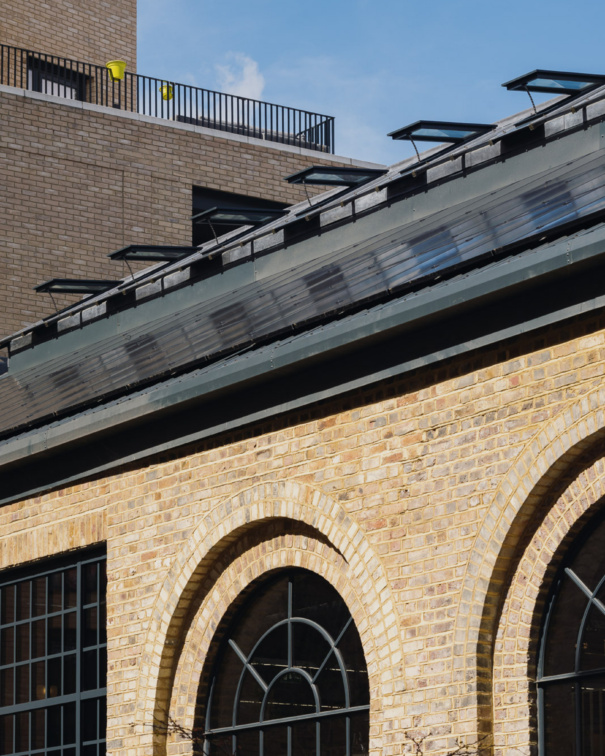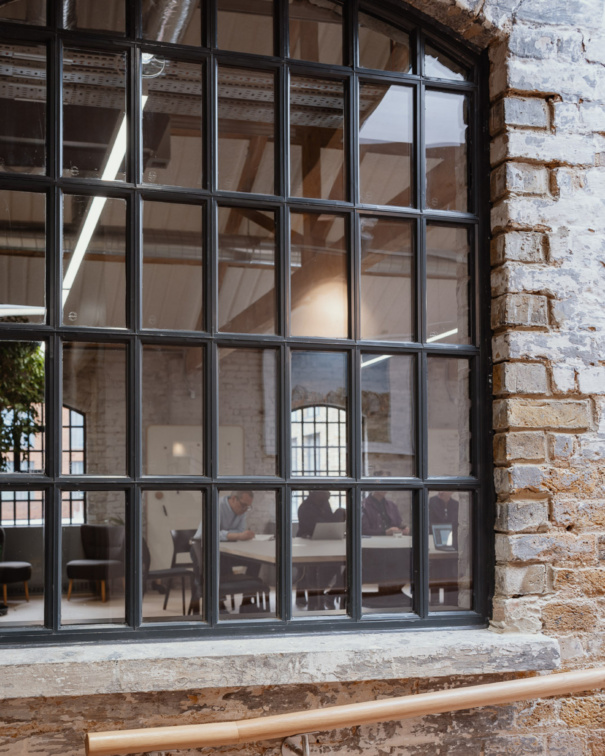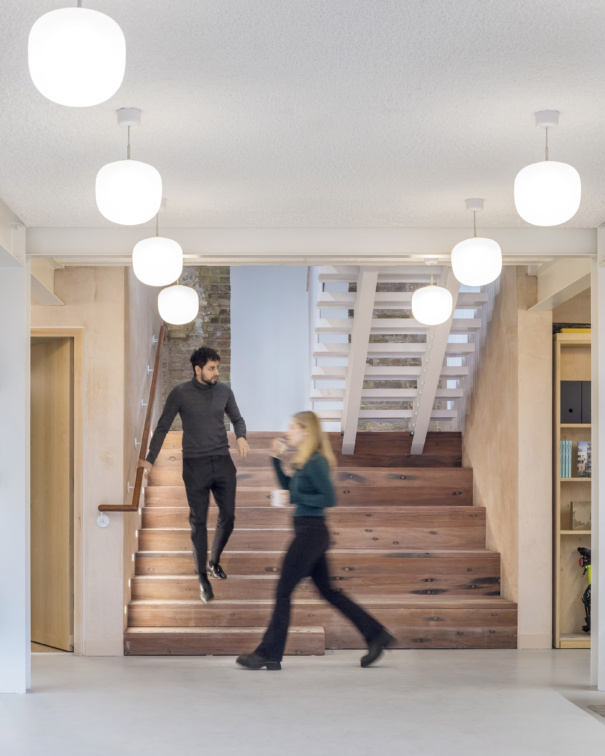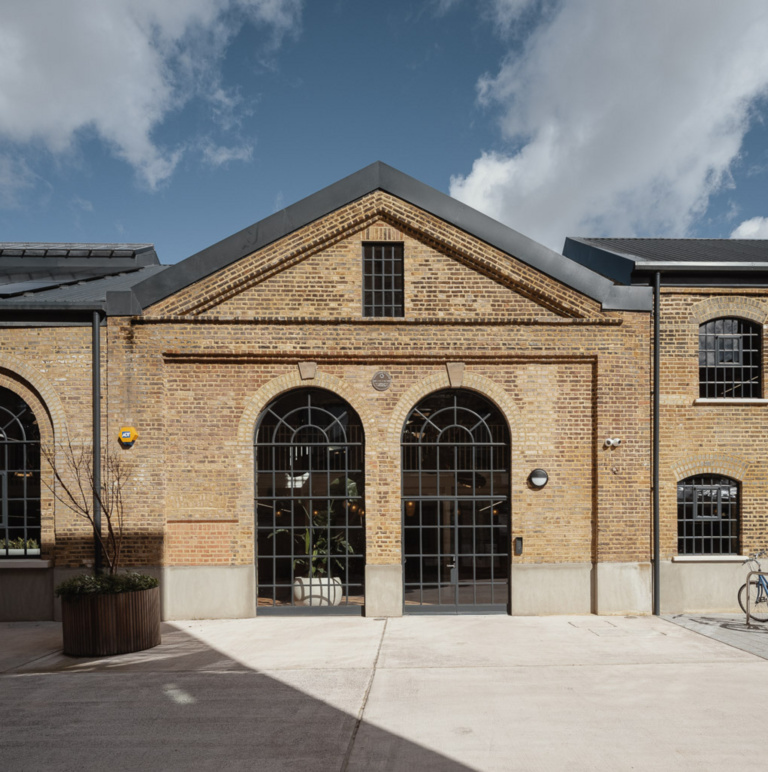HTA reimagined and repurposed a Victorian warehouse in Hackney Wick, East London, creating a permanent new home for its 200 London-based staff. Built in 1868 as a factory to manufacture the world’s first synthetic plastic, the warehouse originally comprised four separate buildings and was identified as a significant piece of heritage within the Hackney Wick masterplan. This intervention demonstrates what can be achieved when a company acts on the needs of its people. It sets the bar for creative-led businesses keen to achieve organisational resilience by shaking off the prohibitive cost of London’s corporate core. The outcome provides an environmentally and socially sustainable new purpose to the building.

75 Wallis Road
The restoration of a Victorian plastics factory to create a 21st century workplace as our new permanent home
One Place, Many Stories
Architecture

What is the context and history of the building?
75 Wallis Road is situated in Hackney Wick, an area with a history of innovation and making. Originally built in 1868, 75 Wallis Road first served as a factory for the manufacture of Parkesine, an early manmade plastic that offered an alternative to ivory and tortoiseshell, since then, the building has had many lives, as the home of cabinet maker Bernard Parker; as the store for Lesney products, the manufacturer of Dinky Toys and as a communist book warehouse. HTA acquired the building in 2020, following a ten-year search for a new home. 75 Wallis Road commanded respectful treatment to safeguard its sense of place. HTA’s approach retained and highlighted the original large span timber trusses, supporting ironwork and local brick envelope.


Design innovation
Our design approach retained and celebrated the hugely varied brickwork structure and the large timber and ironwork roof trusses. The addition of mezzanine floors, staircases and rooflights helped connect the four separate buildings into one seamless, fully accessible, interconnected whole workspace with added drama of huge double height spaces. The spaces within offer the variety and flexibility essential for today’s needs, but with future adaptability in mind. A muted colour palette celebrates inspired by the existing building fabric and draws on precedents and history of the surrounding context. Recycled timber and cork add to the natural finishes and as well as the reuse of all joinery and furniture from our previous home in Aldgate, optimising circularity as part of our sustainability ambitions. The result is a bright, light-filled, and calm atmosphere for staff and visitors.



A fully accessible WC and shower room is provided. At first floor level, the team had to carefully infill floor voids and form openings between spaces to install a DDA compliant lift. Where the existing fabric meant a walkway couldn’t be lowered, they designed a small internal ramp with a new skylight above.
The project demonstrates what can be achieved when a company acts on the needs of its people, setting the bar for creative businesses keen to achieve organisational resilience.



HTA have a culture of care and collaboration, how was this reflected in the design of 75 Wallis Road’s interior spaces?
Our organisation works hard to support the individual and collective wellbeing of our team, our efforts have been recognised with the Architects’ Journal Employer of the Year Award in 2018, 2022 and 2023. This culture is reflected in the design of specific spaces at Wallis Road, the in-house team ensured the building provides something for everyone. A series of hardworking spaces that reflect an understanding of their own organisational culture.
The Snug is a lockable domestic scale room that plays multiple roles. It is equipped with a breast milk fridge to support our new parents. A wudu, used for washing before worship has also been installed allowing it to serve as a multi-faith prayer room. The space suits smaller meetings and 1-2-1 sessions.


The ‘LuncHTAables’ has been designed so every team member can come together in the middle of the day to share a nutritious lunch. The area supports creative collaboration with its floor to ceiling whiteboard, allowing teams to ‘pin-up’ and critique designs in progress. It doubles as a space for public and private events and provides the backdrop for ‘Makery Make’ a monthly series of craft workshops and, our regular programme of talks and networking events.
On the upper floor a large meeting room called ‘The Gallery’ has been left unpartitioned, allowing it to support internal board meetings and design reviews, as well as serve as a bookable space for local businesses. The size of this room, its calm, white-washed brickwork and adaptable lighting make it a perfect venue for evening yoga classes.




How have staff benefitted by the move to Hackney Wick?
Our move to Hackney Wick is a deliberate decision to relocate between the green open space of the Victoria and Queen Elizabeth Olympic Parks for the health and wellbeing of our people with access to nature and opportunities for active commuting. Our location benefits from being situated next to Stratford and Stratford International, providing national and international connections.
Active travel is encouraged through the provision of excellent cycle and running facilities, showers, and drying rooms. A generous open plan kitchen and communal dining area encourages the practice team to come together over freshly cooked lunches, locally sourced, provided by the practice every day.


Since our move in early 2023, we have been working to grow our local network, developing an events and engagement programme that welcomes our neighbours into our new building. This includes hosting community groups, creating links with local initiatives and cultural interest groups and looking to local independent businesses when sourcing supplies.
Sustainability & Building Physics

How did 75 Wallis Road meet specific sustainability standards?
The project retains 150 years of embodied carbon, providing a low-energy, low-carbon workspace for the future. The building has been designed to BREEAM Excellent under the BREEAM UK refurbishment and fit-out assessment criteria (2014).
We respected the existing structure and kept changes to a minimum, inevitably this posed constraints to massing and orientation, so our passive design strategy relies on excellent natural light and ventilation through opening windows and rooflights, well insulated roofs and floors and the significant thermal mass of the retained brick walls.
63 rooftop PV panels are combined with air-source heat pumps to maximise renewable energy. The building operates on electricity only, future proofed for a net-zero carbon grid. Currently, the predicted operational energy use is above the RIBA 2030 operational energy target of 55kWh/m2/year.

New staircase treads are made from locally sourced reclaimed Jarrah, a hardwood with a characteristic red and brown colour. Waste to landfill was avoided by dismantling and reusing old joinery from 78 Chamber Street, our old offices in Aldgate. To ensure storage met our present requirements and allowed us to grow, new joinery was commissioned to the same specification, avoiding wholesale replacement. The professional grade kitchen which adjoins the ‘luncHTAbles’ has been designed around existing equipment, also from our old office, enabling its reuse into the future.



Have circular economy principles informed the design?
Retention of our industrial heritage is a circular act. Care was taken to maintain and extend the life of the brick envelope on the recommendation of a conservation specialist who advocated for exposed brick as a strategy to address damp. Bricks that were removed to create new links between the four original warehouse buildings were repurposed to fill gaps in the building walls. We retained and repaired authentic timber columns in the lunch space, balancing disability compliant, flat level access to the second floor of the building, whilst achieving compliant ceiling clearances was a clear challenge which required an adjusted floor level directly above. Our careful approach ensured most of the columns and their embodied carbon could be preserved.
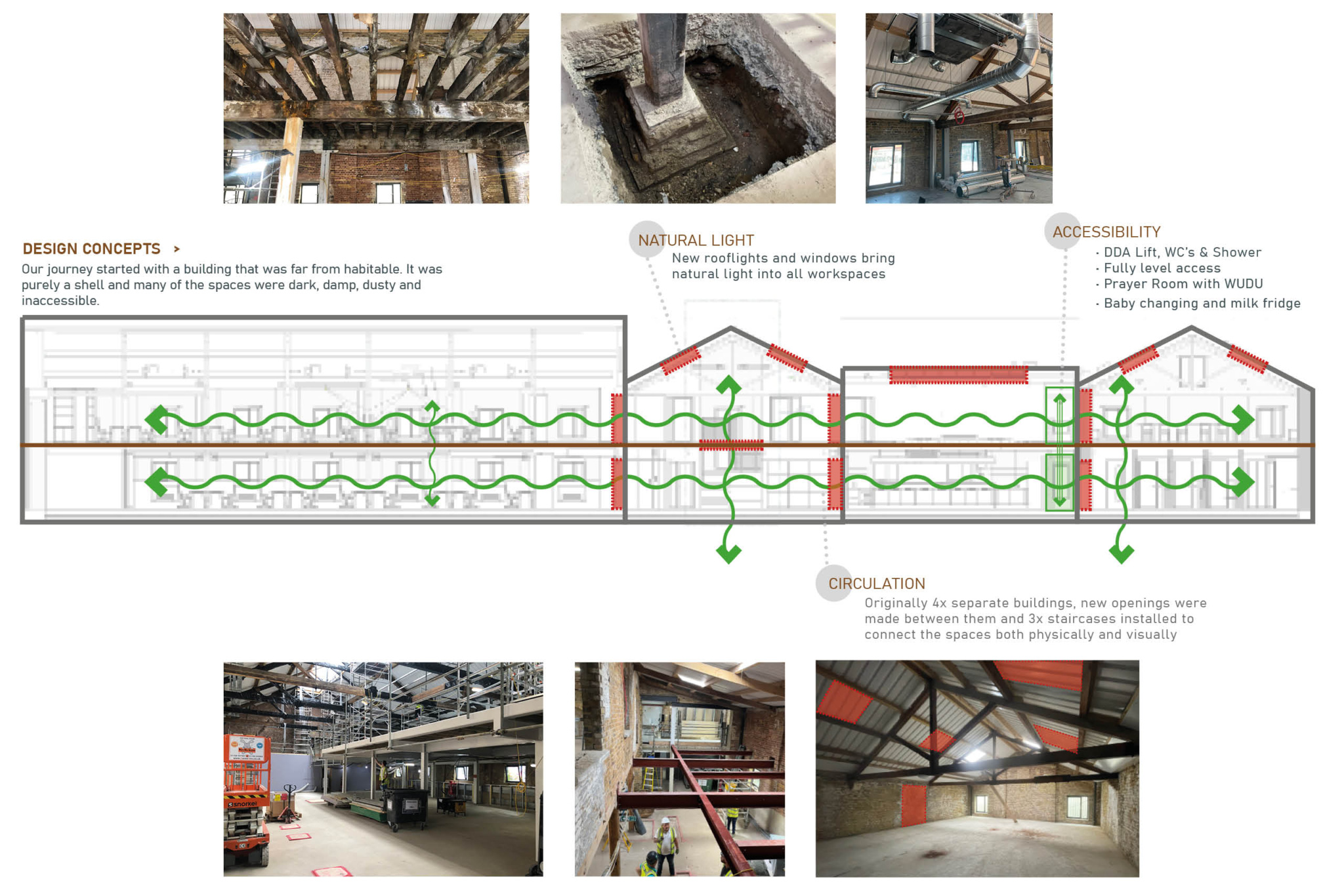
Interior Design

Was the interior design inspired by the history of Wallis Road?
The building is locally listed and positioned within the Hackney Wick Conservation Area. These considerations, combined with a desire to minimise waste, led to a need to retain the existing masonry shell. The repair of this brickwork has informed a warm, muted, colour palette throughout the building with a harmonious pink plaster used to coat new partition walls. Upstairs, a warm cork floor covering has been used throughout.



What factors inspired the choice of materials used in the interior design?
Natural, bio-based and low embodied energy materials were prioritised throughout. This can be seen in the cork flooring on the first floor and the expansive coconut husk doormat which provides a durable finish in the welcome area.
New staircases have been introduced to improve flow around the building allowing dynamic movement around the workspaces. Reclaimed Jarrah, a tropical hardwood with a warm red colour, was resourced from Ashwells, a local timber supplier who we have worked with on our park and playground projects. This was dried and sanded to make our stair treads. As this natural material dries, it is prone to splitting and cracking, we ordered a percentage of wood for contingency. The wood that wasn’t used in the staircase has been used to nestle raked seating under the stairs at reception providing an alternative waiting area to the homely sofas already provided.




